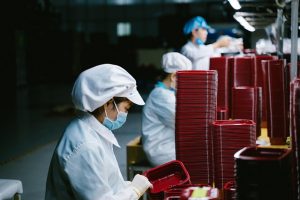By Phillip Raub, CEO of Model No.
Stephen King said, “sooner or later, everything old is new again.” The idea of making products of durable and natural materials isn’t new…but fashion marketers have certainly made it seem that way. Innovation and the evolution of manufacturing technology ushered in an era of fast and cheap goods, which resulted in the shift of consumer purchasing habits. Gone are the days of your mom patching a hole in your jeans, when buying a “new” pair of jeans or chair is cheaper and more convenient.
For some time, it appeared as if future generations would be burdened with stacks of outdated cargo shorts and mountains of polyester. However, an enlightened generation sparked a major renaissance in the apparel space pushing regenerative farming, sustainably sourced fabrics, made to measure/order products and most importantly a resurgence of second-hand goods. Kudos to an industry that only a few years ago was producing tons of landfill waste annually and was hyper focused on developing cheap, disposable goods. The fashion industry still has a long road to hoe…but fortunately many influencers in the space have woken up and are pushing for major changes.
In stark contrast to the fashion industry’s progress is that of the furniture industry, which contributes over 12 million tons to landfills each year (a 500% increase annually in just over 50 years). Largely, this is due to the current fast furniture trend that has filled the gap for trendy styles that are briefly popular. Is this sounding familiar? Not to mention, there is little awareness among the general public of what’s happening in the industry.
Made from low-quality and toxic materials like formaldehyde and other carcinogens, these cheap furnishings have long-lasting detrimental effects within our homes and on a larger scale, our ecological footprint. Even more, because consumers purchase and replace them to match what is ‘in,’ these pieces cannot be passed down and reused by future generations, further contributing to their harmful environmental impact. However, the furniture industry can take cues from the fashion industry and other progressive categories, through circular furniture production models, buyback programs, localized production and domestically sourced materials. The ultimate sustainable model would incorporate reusing pieces from original customers, reusing the materials, and reselling a product that could be passed down to future generations.
It is no secret that previous generations left our children and grandchildren with the tremendous responsibility of tackling the climate crisis. The harsh effects of climate change only became mainstream knowledge around 33 years ago, when NASA’s James Hansen informed the U.S. Senate of the severity of the greenhouse effect. Since then, we have witnessed major climate disasters and environmental injustices take place around the globe at an alarming rate. Despite continuous efforts to combat these effects, it will take drastic measures to ensure a clean future for generations to come.
There are 6 years, 171 days to combat climate change according to the World Climate Clock. This timeline accounts for the amount of time it would take to burn through our “carbon budget”. In order to stop or even slow climate change, industries at large, start up companies, and individual consumers must work together to progress towards sustainable solutions that can help reset the Climate Clock.
As much as the evolution of technology in every industry is largely to blame for climate change, it is also capable of helping to reverse the damage done. An example of this is the automotive industry. While a typical passenger vehicle emits about 4.6 metric tons of carbon dioxide per year, the introduction of eco-friendly, zero-emission cars has flipped the industry on its head. Companies such as Tesla have provided innovative solutions that have not only influenced the industry at large by encouraging other companies to follow suit, but also has impacted consumers’ growing values of sustainability.
Over the past decade, there has been a significant shift in consumer mindset towards sustainable shopping. According to Latana’s Sustainability Perception Index 2020, 61% of consumers think sustainability of a brand is a critical factor when shopping. Furthermore, more than 50% of consumers said they’re willing to pay a premium for sustainable products. This shift in consumer attitude aligns with the increase of environmentally-conscious innovation set forth by industry trailblazers, like Tesla. As the Climate Clock ticks on, consumers are not only realizing the impact of their individual choices, but the urgency of climate-conscious consumerism as a whole. With technological innovations dedicated to sustainability in each industry, we can reset the Climate Clock.
How are you contributing to this global mission?
About the author

Phillip Raub is CEO of Model No., the only direct-to-consumer platform powered by 3D printers to enable seamless ordering and on-demand deliveries, giving rise to furniture that is perfectly tailored to meet the expectations of today’s consumers. Formerly, Raub served as President and Co-Founder of b8ta, the software-powered retailer, where he expanded the brand nationally, internationally and pioneered the retail-as-a-service concept which leverages data analytics to provide brand partners with consumer product engagement and feedback data in real-time. Raub is a retail veteran, industry thought leader and prominent speaker.
Related Articles

Hexnode CEO on how the “Holiday Illusion” is Masking the Risks of Retail’s Seasonal Workforce
The danger of seasonal hires is magnified not just by who is accessing the network, but when they are doing it. Sophisticated threat actors possess a deep understanding of the retail operational calendar.

The New Frugality: How Inflation and Tariffs Are Reshaping Consumer Spending
One of the most telling shifts is how shoppers approach decision-making. Where convenience once dominated, consciousness now plays a larger role. People are researching more before making a purchase, comparing prices across multiple platforms, and questioning whether they really need the product in the first place.

Embracing new concepts vs the return to brick-and-mortar
Balancing the return to physical retail and the development of new technologies to enhance customer experience and drive operational efficiency for long-term success.
Enartis to Acquire Parsec in Winemaking and Retail Deal
The deal will bring Enartis and Parsec together to help wineries manage every part of production more easily and efficiently, from grape to bottle.


 for the latest news and job opportunities in retail tech
for the latest news and job opportunities in retail tech 